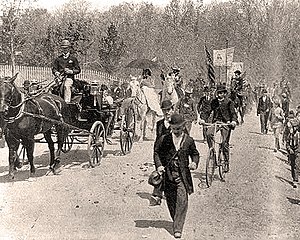Coxey's Army
The climax of this movement was perhaps on April 21, 1894, when William Hogan and approximately 500 followers commandeered a Union Pacific Railroad[6] train for their trek to Washington, D.C.
While the protesters never made it to the capital, the military intervention they provoked proved to be a rehearsal for the federal force that broke the Pullman Strike later that year.
In the novel, Dorothy, the Scarecrow (the American farmer), Tin Woodman (the industrial worker), and Cowardly Lion (William Jennings Bryan), march on the yellow brick road to the Emerald City, the Capital (or Washington, D.C.), demanding relief from the Wizard, who is interpreted to be the President.
In the film adaptation of The Wizard of Oz, the silver shoes were turned into ruby for the cinematic effect of color, as Technicolor was still in its early years when the movie was produced.
[citation needed] In his story "Two Thousand Stiffs" (published in hardcover as part of the 1907 collection The Road), Jack London describes his experiences as a member of Kelley's Army.
The story gives a vivid account on a personal level of the motivations of the unemployed "stiffs", the military style organization of their army, and the more and less willing support given them by more fortunate Americans who were still sympathetic to their cause.
[citation needed] Coxey's Army's arrival in Washington, D.C., sets the backdrop of the 2016 historical murder mystery, A March To Remember, by Anna Loan-Wilsey (ISBN 978-1617737282).
[15] In the prologue to "On the Way Home," the diary of Laura Ingalls Wilder of her family's trip from De Smet, South Dakota, to Mansfield, Missouri, in 1894, there is mention of Coxey's armies.
Lane describes Coxey's armies as coming from California, seizing railroad trains as they headed East towards Washington, and terrorizing towns and pillaging for food on their route.



